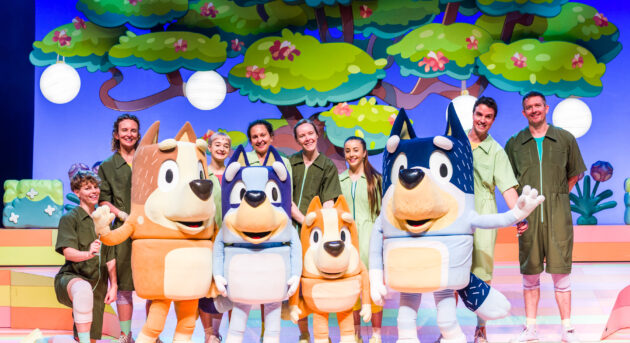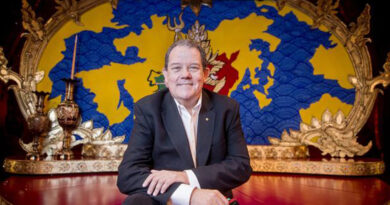The Puppetry Director bringing the Heeler family to life in Bluey’s Big Play The Stage Show.
The irrepressible Bluey, who brought Brisbane to screens worldwide, and captured imaginations of not just kids, but their families too, is coming to life this summer. Bluey’s Big Play The Stage Show will be appearing at QPAC from 22 December 2020 to 10 January 2021, presented by QPAC’s Out of the Box in association with BBC Studios, Andrew Kay and Windmill Theatre Co. Audiences will love seeing their favourite Blue Heeler family on stage, and be enchanted by the recreation of their world, familiar characters and new surprises.
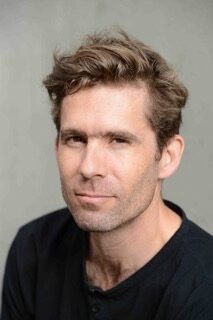
As a mum to an eight-year-old, and a former Brisbane resident, I am very excited about the upcoming stage show. Interviewing Jacob Williams, Puppetry Director of Bluey’s Big Play, was one of my highlights of 2020. I spoke with him about bringing this relatable animation to life with some extra special puppets, and how he got his start in the fascinating world of puppetry.
SW: I was having a look at your bio and I noticed that you started with Terrapin Puppet Theatre in Tasmania. Interestingly, I grew up with Terrapin. Can you tell me how this came about?
JW: I was in Hobart for about three years, around 2000, and I was performing in Cabaret. At the same time, Terrapin were short of puppeteers and ran a workshop for local actors. From that workshop I was chosen to join the company and that’s where I started my career, which was kind of wonderful.
SW: In my memory, they are an incredibly magical theatre puppet troupe. I remember seeing a show when I was in primary school about a mother and a son, and the son always knew that his father had died in the war. It was an intense puppet play for a primary school viewing. but there was this kind of wondrous element which made for a beautiful show.
JW: I think puppetry works so well in metaphors. You can present a show and the audience are going to put on a lot of their own interpretation onto a puppet, because you’ve got to use your imagination immediately to believe this piece of wood is a breathing, animate object, which is certainly part of the puppeteer’s job. I think the audience is the final piece in the puzzle; a conversation between audience and performer, which does happen with actors as well, but is a more intense performance relationship when it works with puppetry, right?
SW: Yes, because you need their imaginations to make the story real.
JW: Yeah, that’s right. So, you do invest yourself a little more in the performance. This can have a longer lasting impression. So often I will perform for adults and they’ll say, “Oh my God, I haven’t been to a puppet show since I was a kid” and they’ll be able to repeat the show that they saw 20, 30 years ago, as children, and the impact it had on them.
SW: That’s amazing. So, you had that opportunity to work with Terrapin. Was it in that moment that you thought, I’m going to pursue a career in puppetry?
JW: I was not enjoying performing as an actor at the time.After I was asked to do puppetry, I discovered this was everything that acting is, and a little bit more. My first role was as the leg of a shadow of a ballerina. It was set inside this tiny proscenium theatre and it had all the theatrical elements that drama and acting has and then an added animation of objects. We are not visible, or even if you are visible, all your energy is directed into the puppet, where you become this background image to the show. I found that very liberating – and the variety of characters that you can play is just endless!

SW: Could tell me a bit more about this journey to where you are now?
JW: I was with Terrapin for three years and then I moved to Melbourne and I got an opportunity with a company called Black Hole to tour a rather Pulp Fiction Grunge-Theatre piece called Caravan. My character was an evil clown. That took me to Europe for this wonderful seven-month tour, going all the way through Europe to Eastern Europe and up to Edinburgh and Ireland. And it was in that moment where I thought, “Oh yeah, I think I could do this as a career”.
I worked with some really experienced puppeteers and some younger puppeteers. And when I came back, I went back to study Theatre making at the Royal College of the Arts. And then, just from there, I began.
It’s a smaller pool of artists, puppeteers. You become known relatively quickly, and often there isn’t an audition process, you are just asked for the gigs. And when there are audition processes, it’s not a cattle call, as such. It gathered pace very quickly and before I knew it, I was travelling the world and doing my own company Lemony S Puppet Theatre with my partner, Sarah Kriegler. Between my own small company and freelancing to other major organisations a jigsaw puzzle of a career began. This took me to Broadway in New York last year and then back to Australia just in time before COVID-19 hit.
SW: I understand that Bluey was in production before COVID-19 hit
JW: Yes, we began in March earlier this year. We had a company meeting one day and then the whole production got shut down, like every theatre company around Australia and around the world. In a way, it gave the company a little more time to think deeply about the design and the puppets. With theatre producer Andrew Kay wanting to bring back a major show, and boldly beginning this process early, we jumped back into it. It’s great that there are producers like Andrew who push us forward to kick start the arts again – like many smaller companies are doing also.
SW: People are really responding, aren’t they? People are wanting to get out and see things again.
JW: Absolutely. There is a real buzz about Bluey. We have started auditions again up here in Canberra. There is a real buzz around the community that there’s going to be some previews here. It’s a particularly wonderful show to be a part of to enter back into performance because there is a really loyal following.
SW: Before we talk about the stage show I wanted to ask you some more questions about puppetry. You have gone from puppeteer to puppetry director. Does that come hand in hand?
JW: I think it’s happened now that I am of a certain age. I still perform, and I certainly haven’t said that I would never perform again. My role with King Kong on Broadway was more of a senior position, where I was the head of the puppetry department and that had an assistant role to the movement director. Coming back to Australia, it feels like a natural progression, an extra feather to the bow which will open other opportunities. I have done a lot of work with companies where the show has an element of puppetry, and I’ve been brought on as the puppet director and teach the skills to the actors. One of these was Hand to God, I was working with Gyton Grantley. He had a real love for puppets as a kid, and he had a particularly hard job where he had to be present as an actor, but with a Muppet-style glove puppet on his hand that was alive at the same time. That required a real split-brain focus, so I had to teach him that and he absolutely loved it. It was a real challenge and really enjoyable experience to share that knowledge.
It’s a challenge too, because often when you’re training actors their instincts and skill base is ‘look at me, I’m the actor – this is the vessel to tell stories’. Whereas with the puppeteer you’ve got to push that ego into the puppet, and so that’s always a fun challenging dynamic to explore.
We’ve got three to four actors on stage with the Bluey puppets, and a couple of dancers and three very experienced puppeteers. It’s a real mix of skill that we have on the stage to bring the story to life, and the challenge continues.
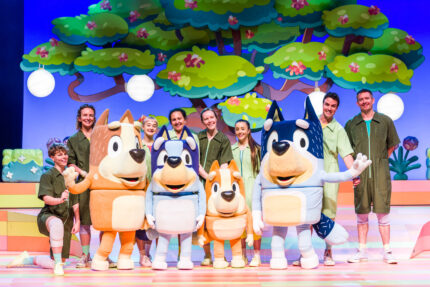
SW: How are the puppets operated?
JW: They’re a hybrid form of a technique called bunraku, which is a Japanese puppetry style where the puppeteers are holding the puppets with their hands from behind. Their hands go internally into the back of the heads and there are mechanisms inside which might be eyebrows, or eyelids; the eyes move, and the mouth moves. There’s a secondary puppeteer who will work the arms by manipulating the arms of a rod, and then the same for the feet. The puppeteers in our show are always visible and the puppets are huge. Bandit (Bluey’s dad) is the size of the actors who are puppeteering.
There’s a strength required and during this four-week rehearsal period, the puppeteers themselves are gaining strength and becoming performance fit by handling the puppets every day. On the first day they were like, “oh my God, they’re really heavy”. Whereas now it’s much more manageable and they’re becoming very fit and very cut. It’s the Bluey diet.
SW: That’s very funny. I can’t wait to see them. Do you have a favourite puppet character of all time?
JW: Do you mean that I have performed, or in existence? I am a fan of bunraku style puppetry, but also, I grew up with the Muppets. One can’t go past the Muppets! When I was in New York last year I had the privilege of meeting Sheryl Henson and became friends with Sheryl in the workshop there. It was a bit of a highlight to go into the workshops and see the original Kermit and Oscar the Grouch all on display and seeing the workers making them in the workshop. In the opening of their workshop is the original Snuffleupagus there to meet you – you just want to give him a big hug the minute you walk in.
To be honest, I’m primarily always a theatre maker. If my company is making theatre, we think of the story first and then we adapt what form of puppetry will serve the story best. Whether it is shadow puppets or a bunraku puppet or marionette puppets, the style of puppeteer you choose will serve as a metaphor for something else, e.g., the themes in the story. In case of Bluey, it is very simple. The characters are really iconic, so you want to see as close representation to those characters on stage as possible.
SW: I like how you said that story resonates with you and how that’s the place that you like to begin. I wanted to ask about the Bluey story and what it was like to translate an animation to a puppet show. You are not working with a script or an idea, instead it’s something that’s already firmly in people’s minds.
JW: We’re working very much directly with Ludo, who created Bluey. Joe Brum has written the script, and we’ve had Charlie Aspinwall and Sam Moor, the producers of the show, be a part of this process as well. It’s been really great to have the brains trust in the room, letting us know, ‘well, this is a gesture that mum makes all the time, so we can do that’. The challenge is that we have this beautiful product, and we want to honour that as much as we can on stage. There are limitations with what the puppets and the stage can do as opposed to what an animation can do. The real test is to try to deliver their movement as close as possible, and to realise that this is Bluey now in 3D, and ask ourselves, “what is that?”.
SW: Bluey is quintessentially Australian and clearly set in that Brisbane landscape. Does that continue in the play?
JW: Jonathon Oxlade, the designer has really taken care of recreating that world. He’s from Brisbane as well originally. It’s very much a flavour of the few animals and side characters that happen on stage and the opening scene of the Brisbane suburb that they live in. I really think kids are going to come and they want to see that world live as opposed to the Heeler’s go on holiday to Hawaii. And that’s the joy of it – translating all those iconic images and set pieces, like the Kiwi rug – seeing those things live on stage that are tangible and you can touch.
SW: In the animation of Bluey there are little ‘Easter eggs’, so, you can see the cover of a record they are listening to and it’s one that you might be listening to yourself. Is there a possibility in the play to do that?
JW: I think the joy of the play is to see some of those favourite iconic things. We don’t have a record – I’ll just let you down immediately. There are a few characters that appear throughout the play, which I think are going to really delight the audiences. I won’t give them away, but they’re very satisfying when you see them in 3D.
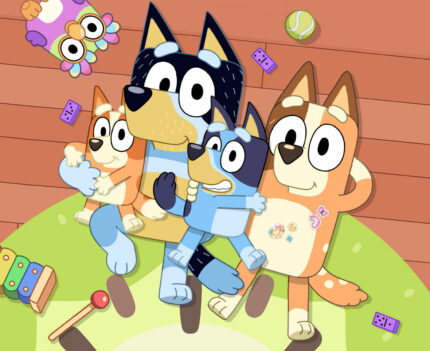
JW: I think for foreign audiences there is a charming element to it. Australia is a unique place in terms of our lifestyle and the space we have, and even the backyards we have compared to some European, American and Asian cities. We’re blessed by a smaller population on a very large landmass and some really quirky animals. I think Bluey delivers that very well. We also have a fairly relaxed sense of humour, which Bluey certainly represents.
SW: This has been a huge year for everyone and it’s really nice that finally (in some areas) families can come together and do things for Christmas. How exciting is it one of those things is that you can come to Bluey?
JW: I was in Melbourne for the full six months locked down. There was a part of me of feeling anxious, coming out of it, and going back into work. But the minute I got back into work I was working with this incredible cast and incredible creative team. I was like, ‘oh, this is just second nature again and just such a wonderful thing to be doing’. It feels really great.
At the end of this week, we are putting the stage show in front of an audience for the first time. I suspect there may be tears. We’ve done all the zoom the meetings we ever want to do, and run workshops over zoom, but now we’ll have the experience of being in front of a live audience again. It’s going to be a real treat and hopefully a peek into the future.
For more information or to book tickets to Bluey’s Big Play The Stage Show visit qpac.com.au

